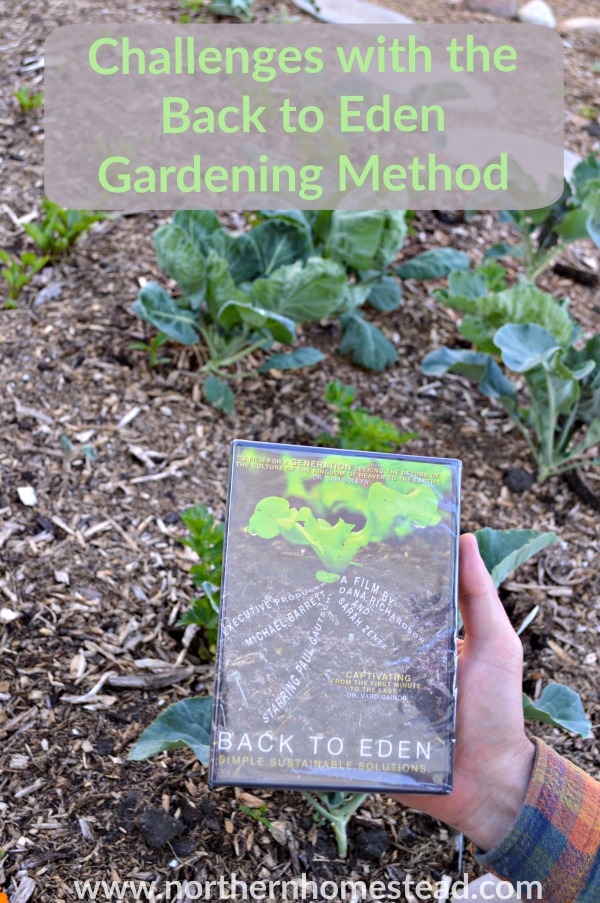
We are big fans of no-till gardening methods. We got into them through the Back to Eden documentary about a sheet mulch gardening method using wood chips or other natural mulch material. Mulching is just the best thing one can do for a garden. There is no longer any need for tilling or digging. However, there are also some challenges with the Back to Eden gardening method.
Recently, we received a reader’s question that addresses many aspects of the challenges with the Back to Eden Gardening Method. We want to address these challenges to help. We appreciate receiving good readers’ questions, so keep them coming. It’s not that we know it all, but if we can help, that’s great.
The reader’s question:
“I’m hoping you can help us troubleshoot our Back to Eden garden problem. We have a 25′ x 50′ garden that we used to till in, re-compost, plant, and weed. We’ve always had a lush green garden but keeping up with the weeds was ridiculous! This is how we gardened for several years.
We started our BTE garden two years ago. We covered the garden area with a layer of cardboard, soaked it down well, covered that with about 2 -3 inches of compost, then covered that with about 3-4 inches of wood chips and left it to break down for a month before planting. Stuff sprouted but never matured, turned yellow and died. We had a lot of slugs (we live in Northern NY, 30 miles south of Canada) and used the diatomaceous earth and also picked them off. After nothing grew we figured we hadn’t given the cardboard enough time to break down for the plants to reach the soil and nutrients beneath.
That Fall we covered the area with some more compost and another layer of wood chips (small sized chips) to winter over for 8 months. This Spring we planted some seedlings and some seeds. We moved the chips aside to plant the seeds directly into the compost. We made holes down to the compost for the seedlings we transplanted, then pushed the chips up around the stems. Again, everything began to turn yellow and has not matured. We tested the soil which indicated low potassium and low nitrogen. Given the original ground soil and compost were dark and rich we’re not sure what went went wrong with the wood chips. We’ve always had a lush green garden in this area for years. The issue began after we put in the Back to Eden system. We would appreciate any help or information you could provide. Thank you”.
It is impossible to give specific advice without actually seeing the garden, but many things stand out. Let’s tackle them one by one.
A weedy garden

Many gardeners choose to start a mulched garden because traditional gardens tend to have a lot of weeds. The Back to Eden gardening method is appealing because it results in fewer weeds and less work. The idea of covering everything with mulch and not having to weed anymore sounds great.
Not so fast, though; even though it is true that mulch does suppress weeds from growing, it does not eliminate weeds entirely. That’s a common misconception. In our mulched garden, we still have weeds. What is true, though, is that weeds are easier to pull or cut with a weeder tool since the soil is nice and loose, and many weeds don’t even want to be there anymore.
Weeds tell a story. They can be indicators of exceptionally rich as well as poor soil, depending on what weeds are predominant. If the soil is already low on potassium and nitrogen, adding wood chips high in carbon can worsen the problem. It should not affect the soil if the wood chips strictly stay on top, but if working in or in the case of the questioner layered, it can change the soil.
The Cardboard Challenge
After reading the question, I initially thought, “Ah, the cardboard.” Cardboard or newspaper is often used to prevent weeds from growing. However, based on our experience of using it multiple times, we do not recommend using cardboard. Firstly, we haven’t noticed a significant difference in weed suppression. Moreover, and more importantly, cardboard does not break down fast enough to allow roots to reach the soil.
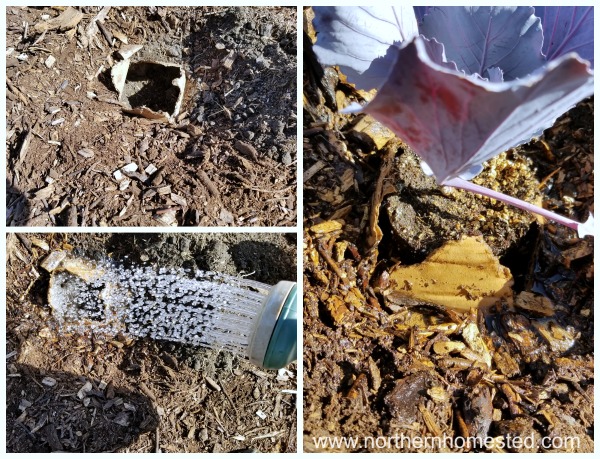
In the field garden conversion we ripped the cardboard to plant the seedlings into the soil. We have seen intact cardboard in our home garden years after layering it down.
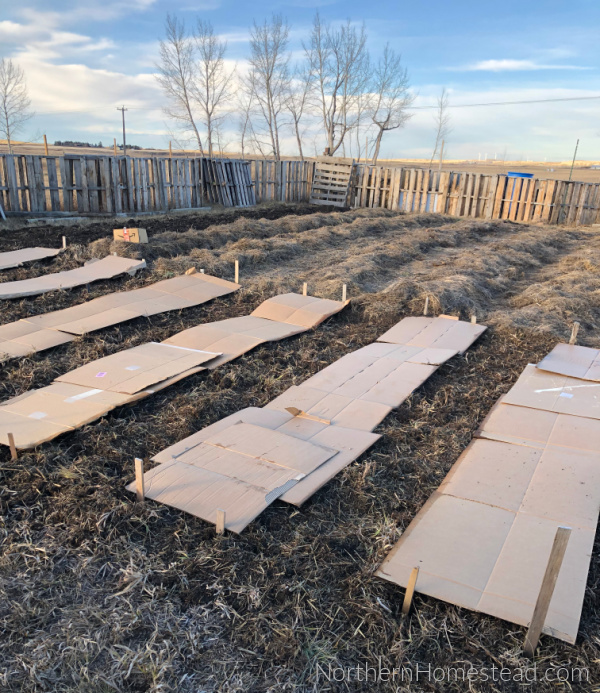
In our country garden we used cardboard only in pathways, leaving the growing area bear, so come spring, the cardboard would not be in a way for the roots to grow into the original soil.
Using cardboard is not recommended, especially when converting an existing garden into a sheet-mulched garden.
Not all wood chips are good for the garden
I do not want to counter the founder of the Back to Eden garden method, and he is right in saying that any coverage is better than none. However, wrong wood chips might not be the best “any covering”. Maybe you are better off with grass clippings or straw instead of bark mulch or wood shavings.
We have used 3 sources to get wood chips. It is not as easy as it sounds, mainly because people do not understand what we mean by saying we want wood chips for the garden. Since most customers use mulch for a nice look, suppliers try to offer bark or woody mulch. And I agree, those do look good in a flower bed, but they aren’t suitable for the vegetable garden.
Great wood chips for a mulched garden method should be from thin tree branches, also called Ramial chips, preferably with leaves, shredded and composted. The finished product looks like wood chips with compost mixed in. Those are compost wood chips.
Fresh wood chips or Ramial chips that are just shredded can also be used again, preferably if they come from branches with leaves. This kind will decompose in the garden, though it does take time. We have used fresh wood chips under trees and shrubs. Planting a vegetable garden into freshly cut wood chips is not a good idea, but they will make great composted wood chips over time.
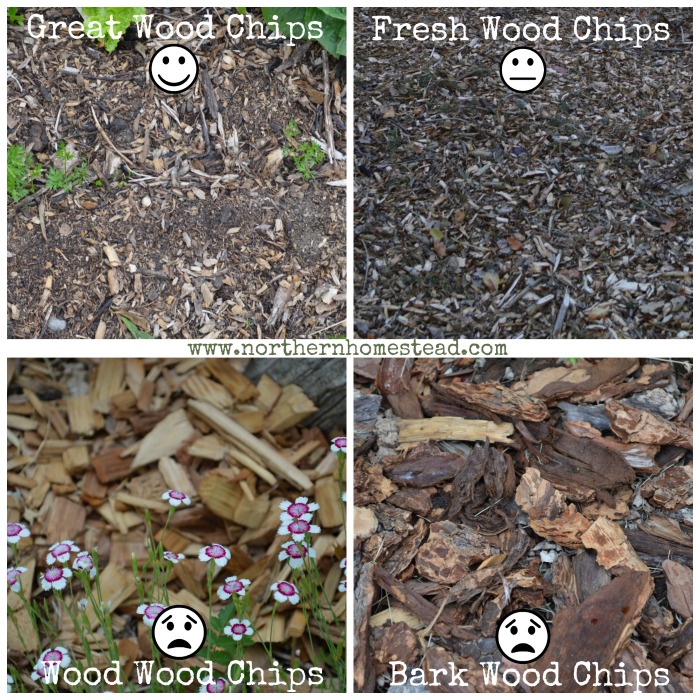
If all you see are chunks of wood, wood shavings, bark mulch, or shredded wood, those are not good for the vegetable garden.
Ask your local tree care service and explain what you want. Most likely, the kind of wood chips or Ramial chips you are looking for is useless to them. We get all the great wood chips for our garden for free.
Germination and planting are more challenging
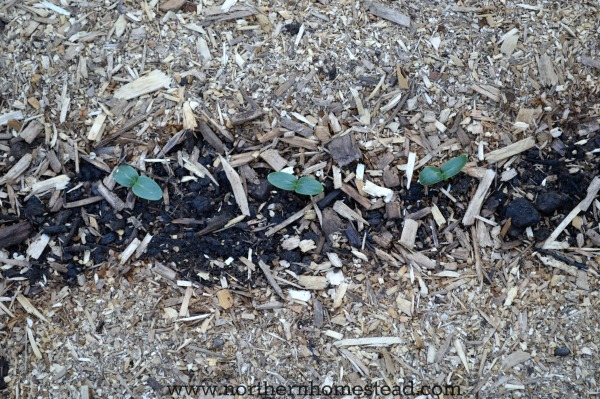
In a wood chips mulched garden, weeds do not grow as much as in a normal garden. This is partially because seeds that land on wood chips will not germinate. We love it. Weeding has become much easier. However, the same is also true for the seeds that we plant.
Moving the layer of wood chips away is important to plant the seeds into the soil, not the wood chips. Wind, rain, and other circumstances sometimes cause seeds to land in the wood chips, resulting in poor germination.
To avoid this problem, you can start planting earlier and deeper. The seeds will need longer to come up, but they will be sturdy and healthy plants. Also, for small seeds, you can use good potting soil or compost to cover them and keep them watered and moist. Once the seeds are up, you will not regret the effort to get them started. Even if you do have gaps, your yield should still be great. You can also use compost instead of wood chips to mulch areas where you plant small seeds (see below).
The wood chips also get in the way of planting new plants or moving and dividing plants. It takes a bit of practice to deal with that.
The slug problem
Wood chips can introduce and multiply a slug problem in your garden, a more serious challenge for areas with heavy rain. Here in Alberta, Canada, we often have dry summers, so the wood chips work for us. However, we still noticed more slugs in our mulched garden than there would normally be in our area. For us, though, the benefits of wood chips still outweigh the challenge with the slugs.
To avoid this problem, composted wood chips should look more like compost and less like wood chips. You can also get the same results using compost without wood.
Note that the important part of a no-till garden is that the soil is covered. Covering with wood chip mulch keeps moisture in. But compost is all you need if you live in a rainy, moist climate. Charles Dowding from England has had a great experience with it and shares it in his books and YouTube Channel. If slugs are a problem in your garden, take advice from him.
The challenge of contaminated compost
One advantage of the Back to Eden gardening method, which primarily uses wood chops, is that there is less danger that the mulch will be contaminated with herbicides. Most other mulch and compost sources, such as hay, grass clippings, or manure rather than trees, can be toxic.
Unless you grow everything yourself that is used in compost or mulch, you have little to no control over what you get. In the case of the questionnaire, neither the cardboard nor the woodchips may be the problem, but the compost was contaminated with herbicides that suppress all plant growth. The fact that the plants turned yellow and died makes me suspicious.
In case of contamination, you can just wait it out; eventually, it will break down. Or you can gather the compost and mulch layers into a pile and let it sit for a couple of years. In the end, you should have great compost to use in the garden.
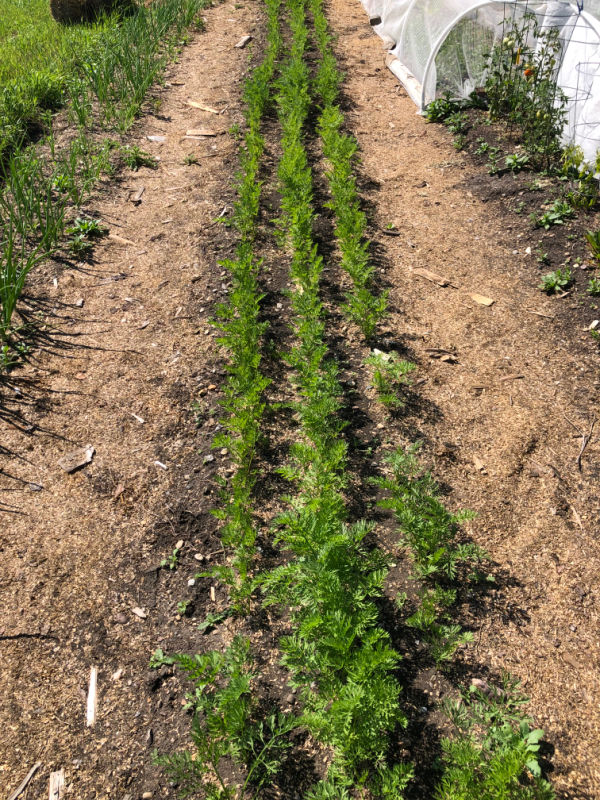
In the doubter case, you can also make permanent beds instead of just a growing area. Use the compost and woodchip mix that causes so much trouble for the pathways and the original soil for the growing rows. Since only the rows need weeding, you will already reduce the weeding in half.
Building Good soil takes time
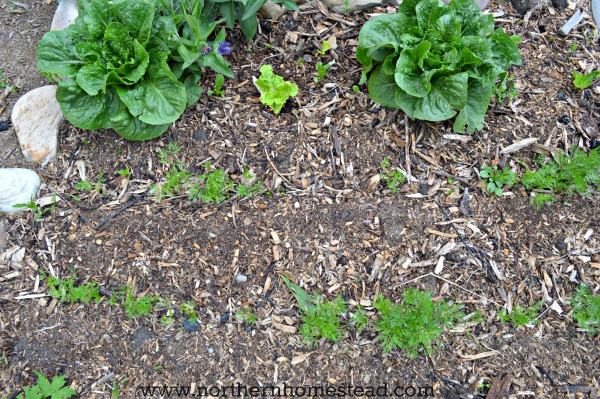
Covering the soil with mulch is a great idea in any situation. However, if you cover good soil, you will have even better soil under the mulch. If you cover poor soil, you will be on your way to improving it, but it will not happen overnight.
A good start for a sheet-mulched garden is to cover the soil with good compost and then cover the compost with good wood chips or other natural mulch material. Over the years, the mulch will encourage worms and beneficial soil life to move into your soil. Your soil will build up and become great—but it does take time.
For the first few years, ensure a good layer of mulch is on top of your soil. If you add it once, you might find out that not much has happened in three years. Especially with poor soil, you must regularly add mulch and compost. Over time, you will need less and less, and your efforts will be rewarded. We hope this will help you get a good start with a natural no-dig gardening method.
We invite you to subscribe to Northern Homestead and follow us on Facebook or Pinterest for the latest updates.


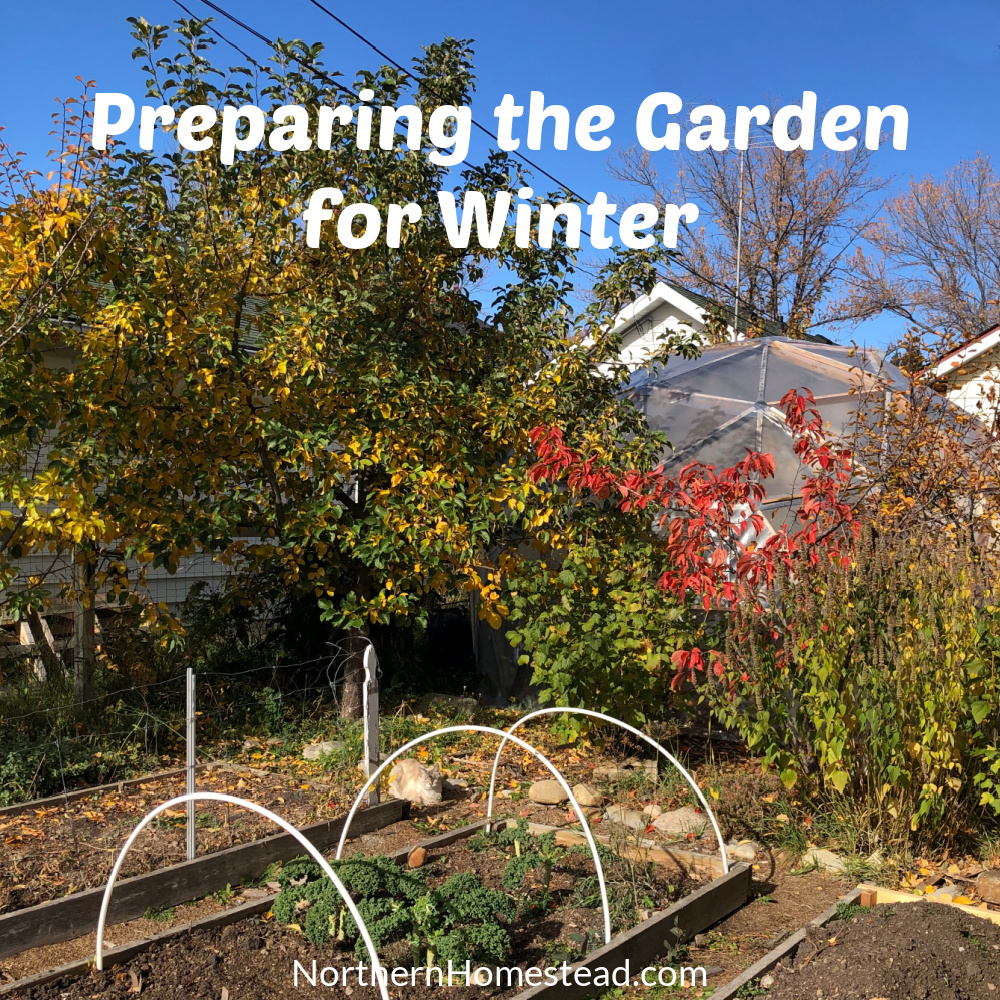


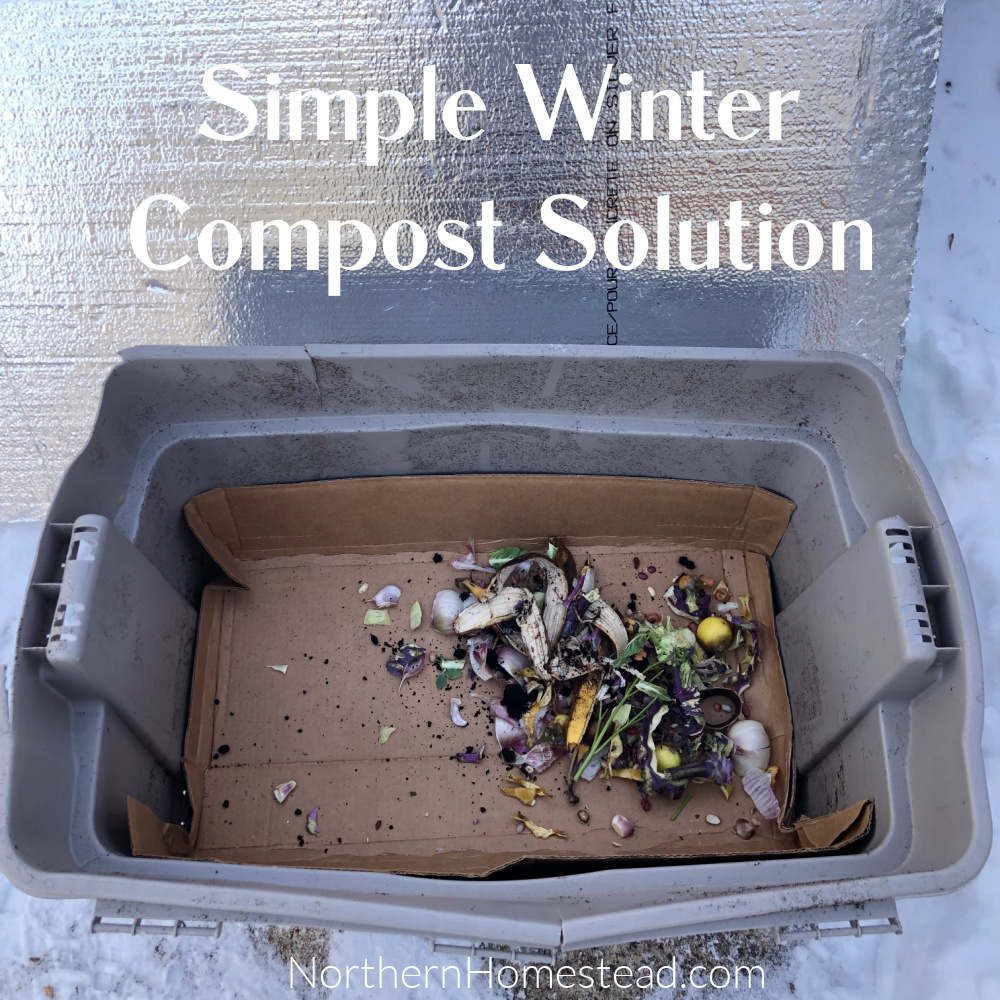
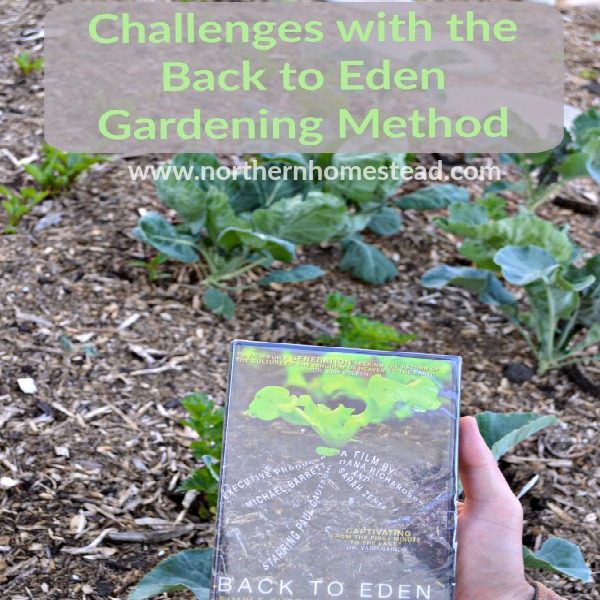
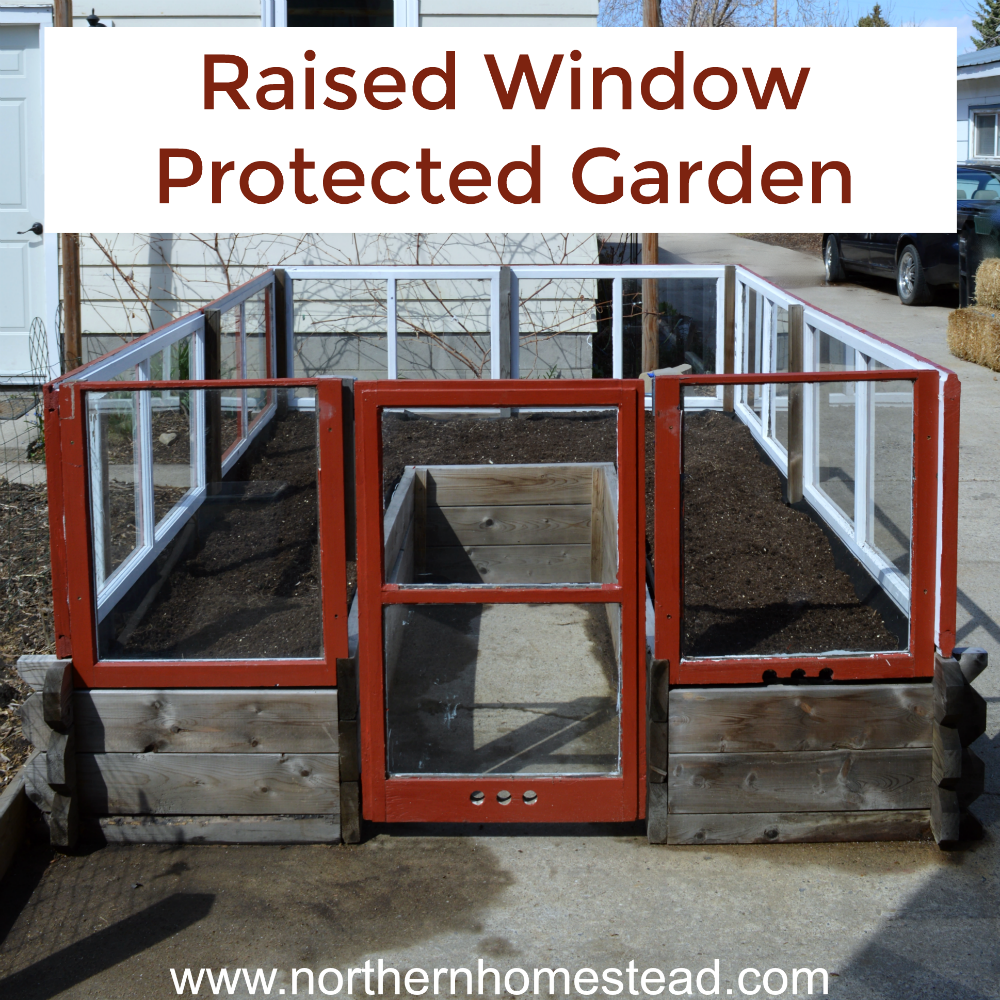
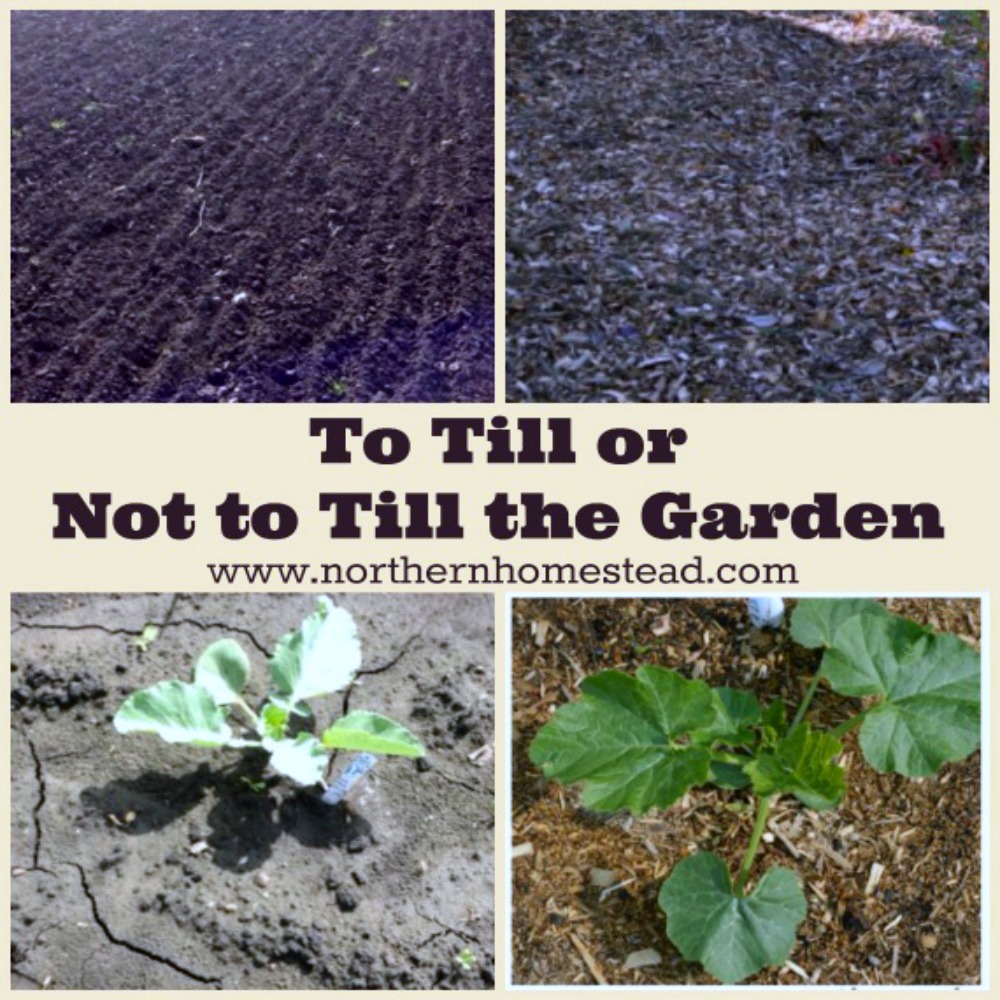

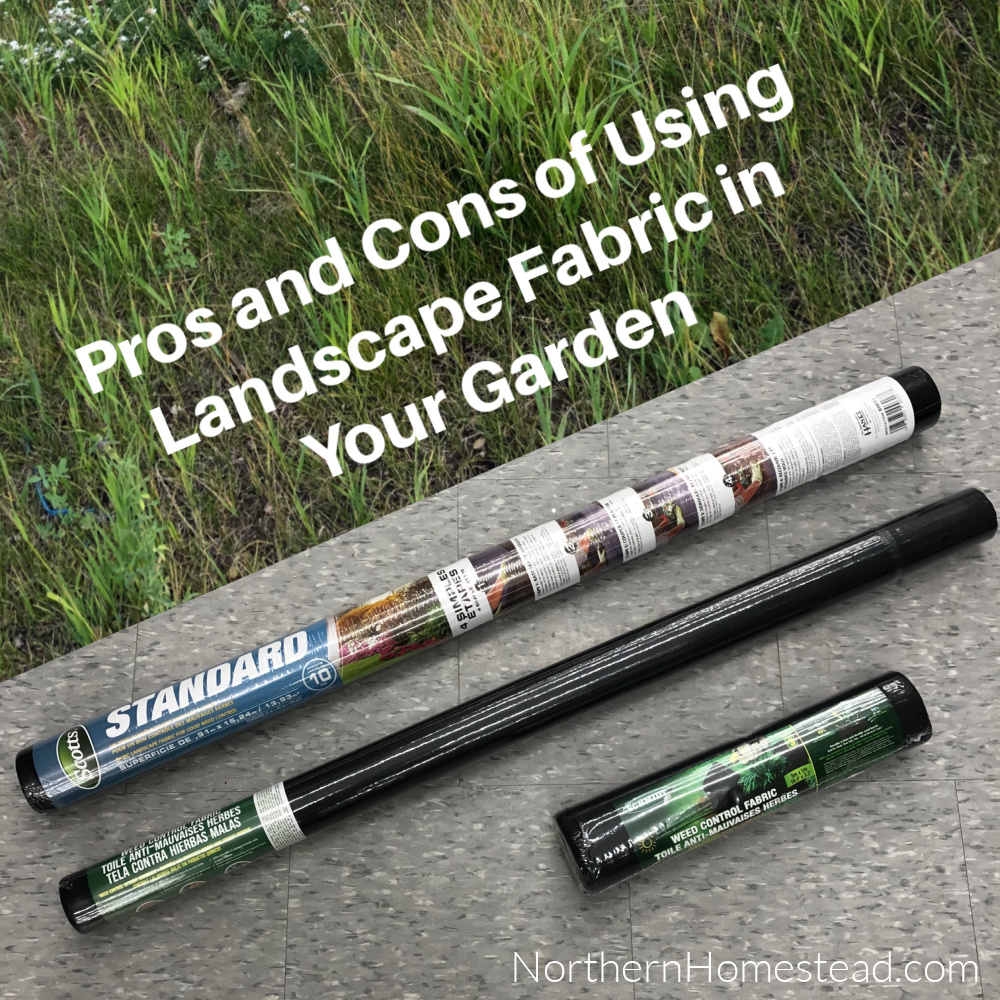
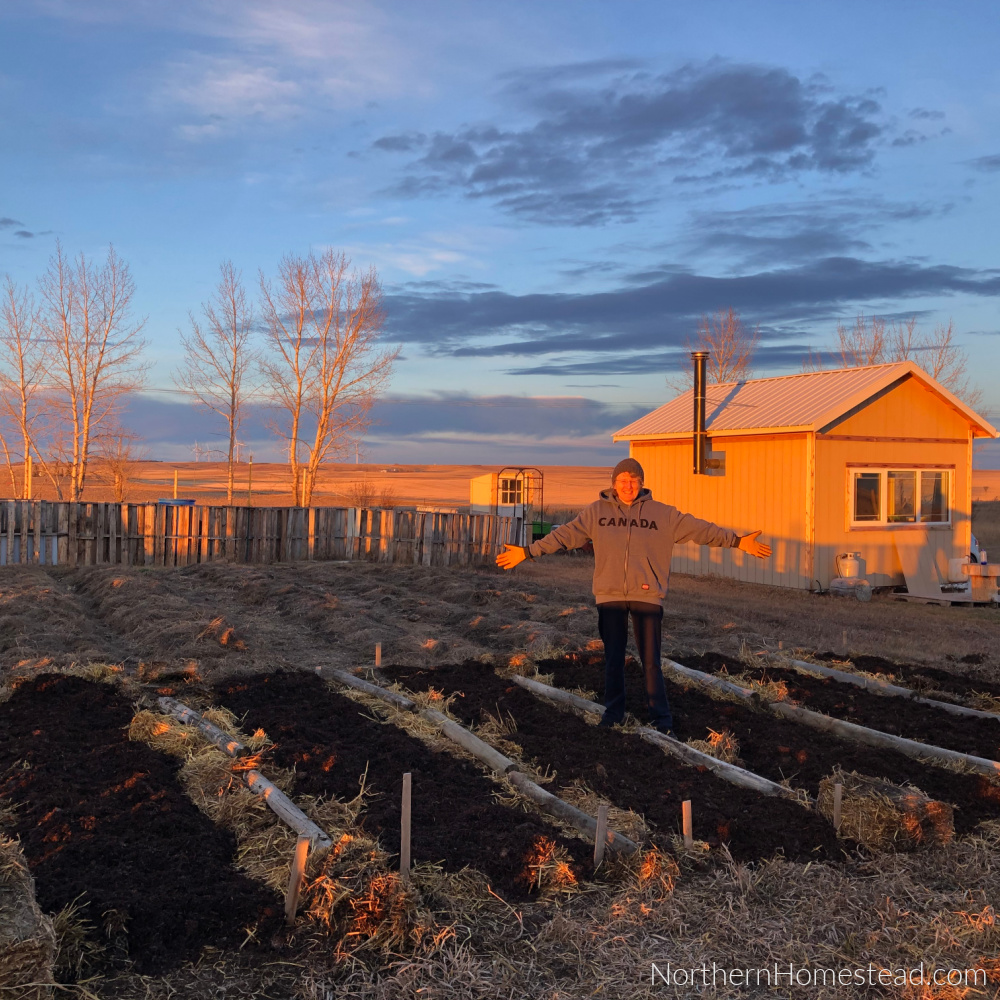

About 8 years ago I started a backyard garden project. I had no viable soil, just plastic covered with lava rocks and struggling plants and down another 2 feet of clay and rock was another layer of plastic. At this point it smelled like a very bad operating sewer. My soil building inspiration came from Ruth Stout and issues of Organic Gardening and I put in 2 years of straw & alfalfa composting and permaculture design techniques. After studying how the rain migrated across my lot I then built my Hügelkultur raised rows from the prepared soil I had made, planted them with my perennials (Rhubarb, Asparagus, Artichoke, Blueberry and others) to slow the water down and sink in. It was between these perennial rows that I packed in about 100 yards of wood chips. After 3 years all those chips disappeared and became soil but the scary thing was I was very close to that old clay hard-pan again, I still couldn’t sink a shovel in any areas except my created rows. I got lucky this year with the discovery of a local project with affordable finished compost for 5 dollars a yard. I’ve put in 18 yards in half my garden and I raised my soil level by a foot. What was most inspiring was when I dug and area and found very happy “earthworms” within 5 inches from the top. I’m not done hauling in this compost but my next curiosity is to see how thick it remains after wintering over. I’m glad I took the time and put the bigger chips down first. If I had it to do over I would have doubled the amount of larger chips then added the finer compost to the top. The larger pieces decompose slower, pull less nitrogen from existing soil and hold water longer.
Thank you for sharing. I hope you are covering your precious compost with wood chips again. That would help to build your soil.
Hi Anna, I’m not done hauling the finished compost yet, that will continue through late fall then it will be allowed to winter over and settle. If it settles down too much I’ll haul more mulch in and fill and level it again. Something I forgot to mention, my husband had 3 strokes and suffered paralyses on his right side from face to foot. With the build-up and leveling of the mulch it has allowed him to walk in the garden. He’ hasn’t been able to do this since 2010 and Memorial Day this year was truly “memorial” because he was able to reach and smell 2 rose bushes that were in full bloom, John F. Kennedy and Abe Lincoln. At this point large chips in the walkways would make it more difficult and could cause him to lose balance and fall.
This is so special, thank you for sharing.
After removing a large section of sod in the back yard, we constructed three raised beds. I regret it now because it’s too confining for what I planted and I would like a much larger garden. We are taking out another section of sod right next to the beds and, once we have picked the final harvest, we may disassemble the beds and spread the soil from the beds over the entire area for next spring planting. We had a garden mix trucked in for the beds in the spring so it was a mixture of soil, compost and manure. I’m wondering if we spread the soil from the beds, will mulch for the final covering be sufficient to leave over the winter? My mulch supplier has a tree trimming business and assures me his mulch, which has been sitting for a year, is the best in our area. Your thoughts on my layers?
My plan is to turn the backyard into my own personal grocery store. 🙂
Love your plan! It depends on what your original soil is like. If you have good soil to start with a bit of compost and a good layer of mulch should be great. However, if there is no topsoil to begin with, you might wont to add some more compost to have better results right from the start.
I just received my first load of wood chips that a local tree company dropped off for free. It was very easy. I googled tree companies who gave free wood chips. I got on two lists. It took two weeks for one of the companies to call to say they had wood chips for me. I was so excited since I had just watched the film Back to Eden Gardening. One thing people need to know is the tree companies won’t bring half truck loads. Expect a huge amount of wood chips. But that’s what you need.
Glad it worked out and thank you for the tip. Yes, more is always better.
Yeah I had a small-looking arborist truck dump a massive amount of tree chips on my driveway. I was freaking out because it flowed onto the sidewalk and it took me hours to move it to my property line. I don’t have a large yard and it’s now mulched 2 feet deep. Yikes! I managed to give half of it away through websites where people stuff away, and luckily it was all used up within 3 days.
Tip: let the arborist dump it in a spot where you’re happy for it to just sit and decompose without interfering with your life. It’ll turn into compost fast because it’s such a huge mound, and whatever chips you feel like using as mulch can be formed out whenever you like.
Thank you for the tip, Tim. We all learn as we go, don’t we?
Thanx for sharing your experience 🙂 i’m happy to see this is working for you in Alberta (we’re in edmonton)! not so happy to hear about yet more slugs but i suppose its to be expected.
We planted in a Lot of compost last yr and it was amazing but ohhh the slugs. our neighbor has an exceptional breeding spot happening, with siding and old tires lining the space between his garage and our plot, my dear heaven, i’m very ok to share but these devils have insatiable appetites! i tried egg shells coffee beer and all the others – resorted to the best of the worst slug pellets by the end of the season.
started looking at Back To Eden method for this yr, having much less time to water and tend. i have a few plans for slugs, including a 1′ strip of gravel between the neighbor and the garden, and lure-patches of marigolds and bokchoy.
i’d love to hear that you’re managing them (?) and how!
We do not have such a great slug problem, thankfully. Could you introduce a few ducks to your garden? They would take care of the slugs for you in no time.
I manage slugs by laying out chunks of fruit peelings (orange, watermelon rind, banana) and checking them early in the morning and right before bed. I hand pick the slugs I find into a small container with a bit of soapy water. Not my favourite job, but it saves the plants.
I still believe any wood chip is better than none. It will still keep weeds at bay and keep moisture.
I am so happy I came across your blog! We lived in Alberta when I was a young girl. We traveled most of the province in the summers, as my dad built Quonset hut foundations for many of the big farmers and ranchers. During the school year, we lived in Mossleigh and Arrowwood. We are from Washington state and I now live in the SE part., originally from the Seattle area. Here in the Columbia Basin, we have a bit longer growing season than you, but get very cold winters and hot dry summers. Many of your tips and advice I’ve found very helpful. Thank you for taking the time to share all your valuable knowledge and experience! I hope spring is on the horizon for you, we had very late snow and cold here this year, and truly felt like I was back in Alberta! I look forward to following you on Facebook and Pinterest. I already shared your FB page with my local gardening group. Happy gardening and thank you again for all the wonderful information. 💕🌱
Welcome, Shawna and thank you for your kind words. It means a lot to hear that what we write here is helpful. Spring seems to be early this year for us, most of the snow is gone. We might get some more, but enjoy it for the moment. Happy gardening to you and your gardening group.
Hello, and thanks for the article! We are beginners and started Back to Eden gardening in our back yard this year, with the unhappy face ‘bark wood chips’ as mulch and we now are happily eating squash, beans, strawberries, tomatoes, root veggies, herbs and the melons and cucumbers are beginning to grow! I made sure that the wood chips were not dyed, just raw forest material. Why do you say this kind is bad for a vegetable garden? Is it just that it decomposes more slowly?
One other issue we’re wondering about now is how to apply the compost we have made, any tips? Thank you for any info!
Yes, it would decompose more slowly and is harder to plant small seeds in. Compost always goes on top, but since your bark wood might take so long you can try what we did. We made rows for carrots, pushing aside the bigger chunks, planted the seeds and covered with a compost mix. This way it was easier to plant the small seeds and after the carrots germinated, wind and rain pushed the wood chips back. Hope this makes sense.
Here in TN it’s better to use the Ruth Stout straw method. With our wet summers, the wood chips bring the slugs. And our TN weed seeds DO grow in wood chips. I loved all the lamb’s quarters (at first) for adding to the compost piles, but after a while they are tedious to keep up with before they go to seed. Many other TN weed seeds seem to love wood chips too. I DID find however, that if you are building a brand NEW garden spot or adding rows, digging wood chips deeply into our hard pan clay, along with gypsum, is a must. Hope this helps.
Thank you for sharing your experience. Simply using compost as cover also works great for areas with slug problems.
If all that you could find was sawdust, would you use it? Thank you.
Yes, for sure. Sawdust as mulch will suppress weeds and keep moisture in, so it has its benefits. However, it would not add much nutritional value. It’s great for strawberries or garlic. The MIgardener has videos about it, check it out. If you have asses to fall leaves, you could mix the sawdust with shredded leaves, it would prevent the leaves from getting to compacted and add some benefits to the mulch.
This was my first year using a no-till approach to my garden – it’s a 20′ -x 30′ plot. While I had tilled in some very old cow manure in 2019, the first year, the soil was still hard by summers end and worse in 2020. Last fall we covered the area with about 6″ of leaves for the winter but it was too fluffy so we tilled it then a local arborist brought us a bunch of mulch from trees they were chipping. I covered the freshly tilled soil with about 4 inches of mulch and then moved the mulch away to seed the rows. I was so pleased with the result this summer, fewer weeds, those that grew were easy to pull and with the unprecedented hot summer we had I was really impressed with how well the mulch cover allowed the soil to hold moisture. I only watered the rows 3x. I’m excited to see what next season brings. I do have a question. Should I add my next layer of tree chip mulch this fall or wait and do it in the spring. Thanks love the tips I’ve learned from your blog!!
Happy to hear you had such good results. If you can add the mulch in the fall, that’s great. If not, early spring is good too. Either works. To my knowledge in a real cold climate, where the ground is covered with snow all winter, it does not matter so much when you add the mulch. In a warmer climate, a fall cover is better, simply because it ensures that the ground is covered during the winter.
Have you considered using rabbit foot covering on ground before adding wood chips as it adds nitrogen which wood chips deplete
Rabbit droppings are great for the garden, with or without wood chips. And you are right, manure does help with nitrogen. Paul saus in one of his tours that he uses chicken manure. Not sure why it is not included in the Back to Eden documentary.
I learned the hard way that the beautiful decomposition process necessarily requires nitrogen. So, if you’re creating a garden site that has an active decomposition element, like cardboard breaking down, or new wood chips breaking down, the nitrogen needed for that chemical process will be leached from your soil. That causes all kinds of problems for germinating and newly growing plants and is often expressed as yellow leaves. Lack of nitrogen makes chlorophyll production difficult. I personally am a great lover of the spirit of the Back to Eden method, but am also a lover of reducing all unnecessary industrial-oriented chemical leftovers from the soil, such as using plastics for irrigation or netting, etc. Perhaps excluding the cardboard would prove best. With the Back to Eden method, you’re basically creating a huge compost bed, and that isn’t really a great medium for plants until sufficient breakdown has occurred. If we are lucky, we get to live long gardening lives and observe and experiment as we interact with the processes as Mother Nature intended. Mimicking her wisdom as much as possible whenever we can.
Thank you for sharing your input. Well composted wood chips are best. Fresh can be used in phat ways and moved to the garden once composted well, replacing the pathways with new wood chips.